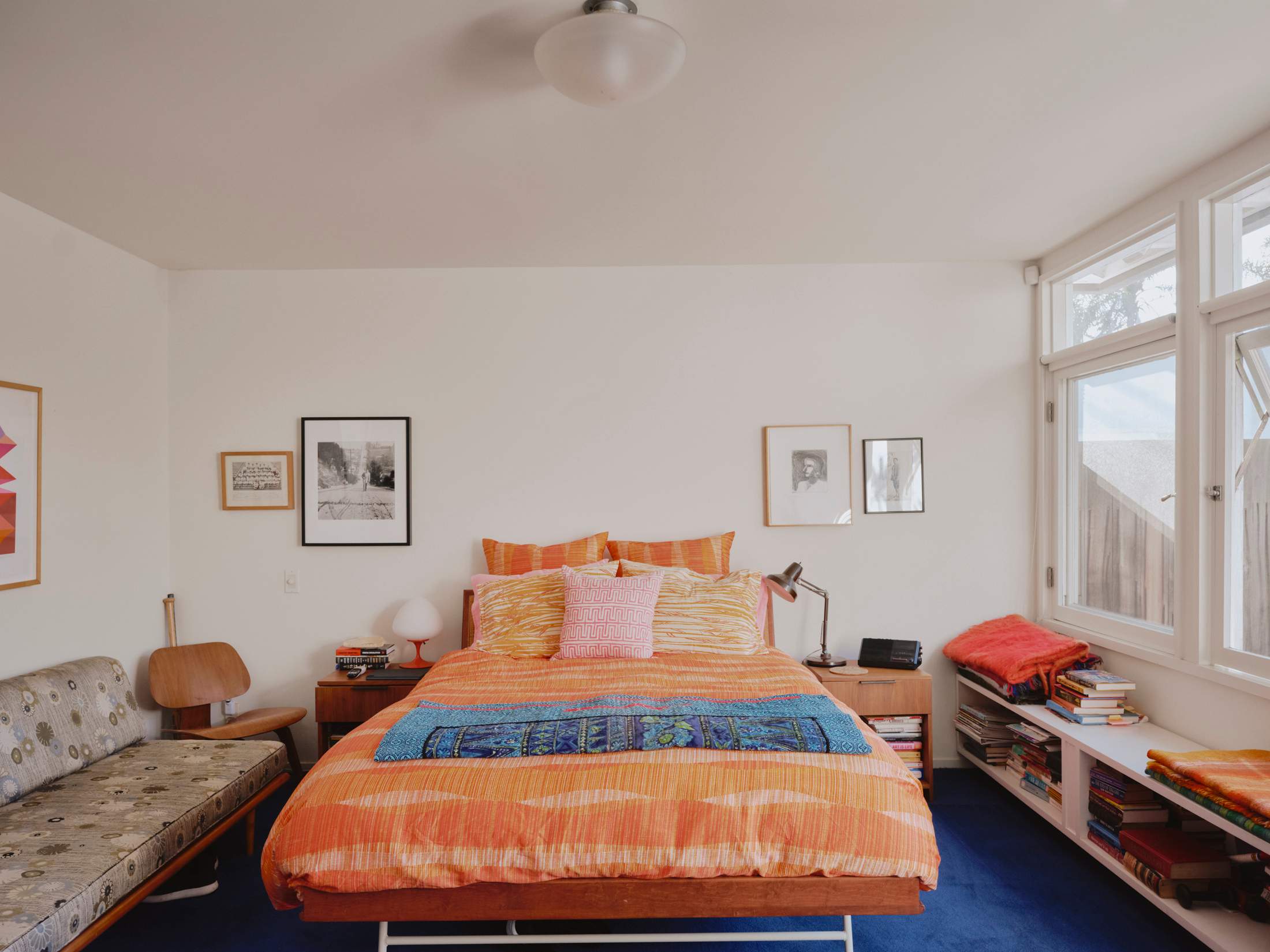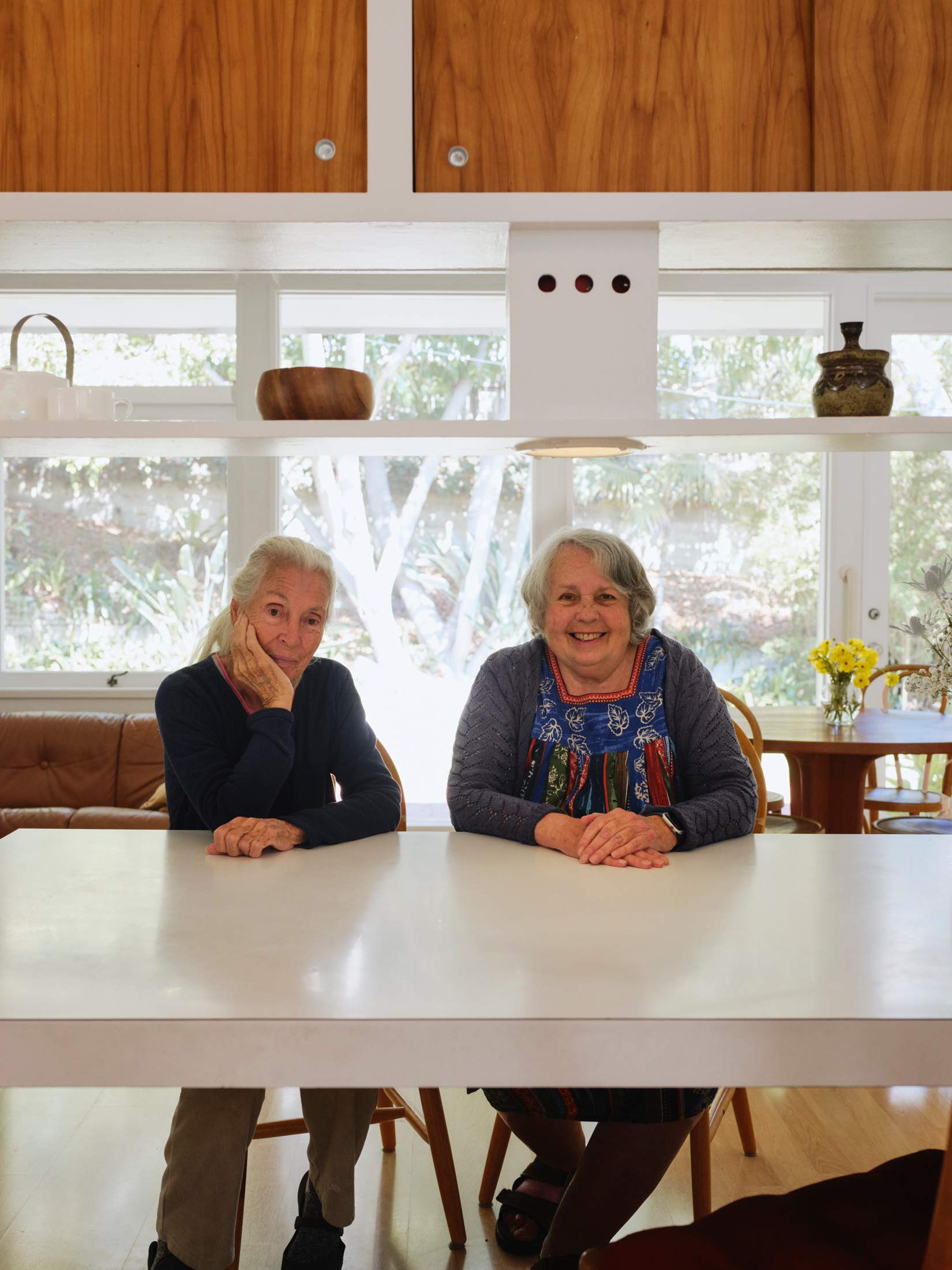Design: Residence / Los Angeles
Level best
A set of humble 1940s bungalows designed as ‘social art’, the Mar Vista Tract has nurtured a community and is beloved by its residents.
When Gillian Tennant and Steven Summers started house hunting in Los Angeles for their family of four, they had the goal of any reasonable Aussie transplants: a modern home not too far from the beach. They happened to be driving past a stretch of low bungalows on Beethoven Street, just off Venice Boulevard, when they were stopped in their tracks. The houses would probably have passed unnoticed had it not been for the gathering that was taking place out front. “In someone’s yard, there was a live band playing, with people sitting on the lawn listening,” says Tennant. “That’s something you don’t see anywhere. We said to each other that this is where we want to live.”
This scene of 1950s-era neighbourhood bonhomie that Tennant and Summers had stumbled on is typical for the Mar Vista Tract. A grouping of 52 houses that runs three streets deep (Beethoven, Moore and Meier Street, from west to east), this modernist enclave is easily missed when driving through the flat suburbia that sprawls out east of Venice Beach. The main decoration on the small, colourful bungalows are slim, V-shaped trusses that hold up awnings over garage doors and entrance walkways. But when Tennant and Summers fixed their mind on living in one, they had to get in line. Mar Vista Tract residents hardly ever leave; when a house does go up for sale, bids can exceed $2m (€1.8m).
In Southern California’s modernist architectural heritage, which mostly consists of the ritzy and secluded single- family villa, the Mar Vista Tract is a misfit. So was its architect, Gregory Ain, the child of a socialist Polish émigré who grew up partly on a commune. Ain viewed architecture as a “social art” that should address the “common architectural problems of common people”. After working in the drafting room of Austrian master Richard Neutra, he opened his own office in the late 1930s. By the mid-1940s, together with associates Joseph Johnson and Alfred Day, he started planning the Mar Vista houses.
Ain himself referred to his masterplan as a tract – a term connoted with a kind of repetitive, characterless suburbia. In Ain’s design, the houses have the same basic layout and average just 98 sq m but every millimetre was carefully considered. The architect developed a plan that maximises space and flexibility using sliding doors and an open kitchen. By flipping and rotating this floorplan, and varying the position of the garage, he made every home slightly unique. Just as much thought was given to the surrounding green spaces. Ain’s frequent collaborator, Harvard-educated landscape architect Garrett Eckbo, drew up fenceless, communal gardens planted with species from six continents. Each parallel street had its own plant-lined walkway: ficus for Beethoven, melaleuca for Moore and magnolia for Meier. Backyards were dotted with loquat, mulberry, plum and guava trees to encourage fruit trading and socialising between neighbours.
The houses were completed in 1948 and christened the Modernique Homes (“Modern in design, unique in liveability!”). While keeping mum about Ain’s socialist leanings, the advertising material emphasised his innovative design solutions. “Check these features against homes twice the cost” it urged, followed by a 10-point list ticking off all that Ain had squeezed in, including folding and sliding doors that made space for one, two or three bedrooms, floor-to-ceiling windows and a dining table between the kitchen and living room that doubled as a buffet or a bar.
The design was progressive for the 1940s but prospective buyers, alas, did not take in Ain’s nuanced vision. Though the houses started at a reasonable $12,400 (just over $160,000 in today’s money), they were in a blue-collar area where homes sold for a third of that sum. The neighbouring property was a shooting range. The mainstream reaction to the development is captured in the 1949 film noir Tension, where a newlywed couple arrive in Mar Vista and the husband proudly presents the home he has picked out for them. Behind Ain’s unadorned design, barren fields stretch into the distance. “It’s 30 minutes from nowhere,” says the wife, sliding into the driver’s seat and taking off.
Though the Mar Vista Tract was a commercial failure, it attracted residents who saw the value of Ain’s design, many of them architects and designers. Early occupants included the founders of Architectural Pottery, the company that pioneered modernist ceramics in the US. The tract has also had an LA-appropriate share of intrigue (including one murder mystery) and makes several unexpected cameos in the city’s cultural history (empty pools in the tract informed early designs of skateparks).
When Amanda Seward and Hans Adamson moved in on Moore Street in 1994, they had never heard of Gregory Ain. “This was the only house that we could both agree on,” says Seward. The couple only had a lay interest in architecture: Seward, who grew up in Santa Monica, is a lawyer, while Swedish-born Adamson produces music software. But when they began work on the fixer-upper, which needed a new roof, they started digging into the neighbourhood’s history. The previous owner had left behind the tract’s original blueprints. “He had been an enthusiast of these buildings and I inherited that with the house,” says Adamson, who started researching the original planting schemes and colour palettes of the homes. “It took years of detective work.”
By that time, in the late 1990s, Mar Vista was becoming a desirable place to live in LA, and the first McMansions had started popping up in the area. Eventually somebody submitted a planning application for adding a second floor to their Ain house but the neighbours did not acquiesce.
Angela Caputo, Ken Kook & Maya Cook
“We moved from Chicago to Los Angeles and happened to cycle by here and saw a ‘for sale’ sign out front – we put a bid in and got it,” says Angela Caputo, who has lived on Moore Street since 2020. “This is a very welcoming neighbourhood. People are so warm here. It would be tough if that atmosphere were lost. Hopefully, many of the neighbours’ children will stay. We hope that our daughter will one day have this place.”




Gillian Tennant & Steven Summers
“We have been surprised by how safe this neighbourhood is, especially for this part of Los Angeles,” says Gillian Tennant, who has lived on Meier Street with her partner, Steven Summers, and their young family since 2023. “We thought we couldn’t let the children out the front door but there are kids running up and down the street. They love it here. The only odd thing is how many people take photos of the house while driving by.”




Takashi Yanai
“I made an offer on a house here 20 years ago and didn’t get it but I always thought that someday I would live in one of these houses,” says Takashi Yanai, whose vision became a reality when he bought a house on Meier Street in 2023. “I want to make it possible for more people to experience this architecture. I have hosted dance performances and art exhibitions; next up is a karate performer. I am thinking about starting an informal artist residency.”





Ruth Handel & Lloyd Scott
“Living in these houses makes you appreciate time in a different way,” says Ruth Handel, who has lived on Moore Street since 1999. “I’m working on a book about life in the tract and have been gathering stories and photos from previous residents. In one stack of photos I received, the first photo was of someone sitting in exactly the same spot I was in. It was a strange moment. You realise that you’re just passing through.”




Bonnie Jones & Anni Michaelsen
“We moved in 54 years ago, six months apart,” says Bonnie Jones, who has lived on Meier Street since 1970, with Anni Michaelsen across the street. “We both had children and became friends. In most houses at the time, the kitchen was in the back and you looked out through a tiny window. Here everything is open. We have never wanted to change our homes. The architect knew what he was doing.”




Hans Adamson & Amanda Seward
“While we were waiting for our bank to finalise the sale, the Los Angeles earthquake hit,” says Hans Adamson, who bought a place on Moore Street, with Amanda Seward, in 1994. “Buildings collapsed everywhere and we came over here to see if our home was still standing. But there was no damage anywhere in the tract. The construction is so light. We often get estate agents knocking on our door but we will never sell.”



A grassroots movement of residents including Seward and Adamson began pushing to make the Mar Vista Tract a Historic Preservation Overlay Zone, or hpoz, which blocks outward changes to a historically significant district. The move was unprecedented – no other postwar modernist buildings were protected by the programme. In 2003, after years of campaigning, 50 of 52 homeowners voted in favour.
“These houses are small and people think that they need to live in a palace,” says Anni Michaelsen, a resident since 1970 who went door-to-door cajoling signatures in favour of the hpoz. Danish-born Michaelsen opened her impeccably furnished home for campaign meetings and cocktail receptions. “I wanted to show what people wanted to tear up,” she said. “If we hadn’t done that, these houses would have disappeared.” Now any changes to the street-facing façades are off limits and most renovation work must pass approval of a five-person board made up of residents and at least one architect.
Mar Vista turned out to be the last large-scale housing project completed by Ain. The architect was hounded by the fbi as a suspected communist, and commissions dried up. It is a fortunate twist that the community spirit that Ain set out to create in Mar Vista is also what enabled this nook of LA to be preserved. “This architecture has a simplicity, openness and democracy to it,” says Seward. “Those are things that I am still attracted to.”
When Tennant and Summers first placed an offer for an Ain house, they were outbid; likewise with a second, a few years later. “We almost gave up,” says Tennant. But last year a house came up for sale on Meier Street and the third time proved the charm. The sunset-facing home was one of the best-kept in the neighbourhood, with welcome extra living space thanks to a tasteful 1960s expansion. The couple have created an LA-meets-Sydney idyll in warm wood and earthy tones, with pieces by mid-century designers Paul McCobb and Bror Boije.
Having settled into life in Mar Vista, the family’s first impression has held up. The tract’s residents all correspond on a reply-all email chain, where there are frequent invitations to barbecues and events. “We don’t have family here, so we really appreciate that,” says Tennant. “If anything happens, you’ll be looked after.” The Australians also feel at home thanks to the amount of wildlife that resides in Eckbo’s 75-year-old scheme. Coyotes, raccoons and squirrels all pass by the front porch, while a stately redwood in their yard hosts a family of hawks.
Across the street from Tennant and Summers is the house of Takashi Yanai, a Japanese-born architect who uses the home as a studio, salon and event space. This summer he invited an LA-based dance company to stage a show around the homes. Suddenly, his new neighbours found themselves at the centre of precisely the kind of event that had first drawn them here. “The performers moved down the street and then stopped in our front yard,” says Summers. “The whole neighbourhood came.” —


